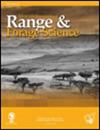旱地条件下的卢塞恩建立:作物残茬和小麦作为护理作物的影响
IF 1.9
4区 环境科学与生态学
Q3 ECOLOGY
引用次数: 0
摘要
摘要旱地条件下种植紫花苜蓿(Medicago sativa)面临着雨季不可预测和幼苗脆弱性的挑战。一种可能的解决办法是在同一块地里第一年采用看护作物。本研究旨在评估小麦作为护理作物和作物残茬对南非地中海气候区卢塞恩形成的影响。实验采用分块设计,在6个区块中设置2个处理因子。一半的地区种植了麦秸,而其余地区几乎是光秃秃的土壤,残留物含量很低。护理作物组合包括单独小麦、单独紫花苜蓿和小麦-紫花苜蓿混合。结果表明,小麦和苜蓿在混种时存在竞争。当考虑到植物种群、总生物量、小麦籽粒产量和籽粒质量时,小麦在纯林中表现更好,而在不种植小麦的情况下,苜蓿也表现更好。高作物残茬对苜蓿的萌发有显著影响。小麦在没有作物残茬的情况下获得了优异的粮食产量,尽管产生的生物量较少。结果表明,在地中海气候区,紫花苜蓿宜避免采用护理种植制度。关键词:伴作涵养农业;间作;土壤覆盖本文章由计算机程序翻译,如有差异,请以英文原文为准。
Lucerne establishment in dryland conditions: effects of crop residues and wheat as a nurse crop
AbstractEstablishing lucerne (Medicago sativa) in dryland conditions poses challenges due to unpredictable rainy seasons and seedling vulnerability. A potential solution is adopting a nurse crop during the first year in the same field. This study aimed to assess the impact of wheat as a nurse crop and crop residue on lucerne establishment in South Africa’s Mediterranean climate region. The experiment employed a split-plot design with two treatment factors across six blocks. Half of the area received wheat straw, while the rest had low residue content with almost bare soil. The nurse crop combinations included wheat alone, lucerne alone, and a wheat-lucerne mixture. Results revealed competition between wheat and lucerne when planted together. When plant populations, total biomass, wheat grain yield and grain quality were considered, wheat performed better in pure stands, as did lucerne when grown without wheat. Germination of lucerne was significantly impacted by high crop residue levels. Wheat achieved superior grain yield without crop residue, despite producing less biomass. Results indicated that it is advisable to avoid using a nurse cropping system for lucerne in this Mediterranean climate region.Keywords: companion cropconservation agricultureintercroppingsoil covermixed farming systems
求助全文
通过发布文献求助,成功后即可免费获取论文全文。
去求助
来源期刊

African Journal of Range & Forage Science
ECOLOGY-ENVIRONMENTAL SCIENCES
CiteScore
4.00
自引率
14.30%
发文量
35
审稿时长
>12 weeks
期刊介绍:
The African Journal of Range & Forage Science is the leading rangeland and pastoral journal in Africa. The Journal is dedicated to publishing quality original material that advances rangeland ecology and pasture management. The journal aims to publish research of international importance from any region, but as an African journal, we are particularly interested in research from Africa and relevant to the continent. The Journal promotes both science and its application and authors are encouraged to explicitly identify the practical implications of their work. Peer-reviewed research papers and research notes deal primarily with all aspects of rangeland and pasture ecology and management, including the ecophysiology and biogeochemistry of rangelands and pastures, terrestrial plant–herbivore interactions (both domestic and wild), rangeland assessment and monitoring, effects of climate change on rangelands, rangeland and pasture management, rangeland rehabilitation, ecosystem services in support of production, conservation and biodiversity goals, and the identification and development of intensive and semi-intensive pasture and forage resources to meet livestock production needs. Articles highlighting transdisciplinary linkages among biophysical and social sciences that support management, policy and societal values are particularly encouraged. The Journal includes relevant book reviews and invited perspectives that contribute to the development of range and forage science. Letters to the editor that debate issues raised in the Journal are acceptable. The African Journal of Range & Forage Science is the official journal of the Grassland Society of Southern Africa.
 求助内容:
求助内容: 应助结果提醒方式:
应助结果提醒方式:


